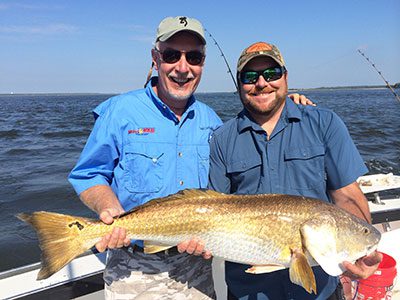
As summer gives way to fall, the days begin to get shorter, nights become a little cooler and football season goes into full swing. These factors, except maybe football season, signal fish to start their semi-annual migrations to their winter hangouts. Basically, you’re dealing with springtime fishing, in reverse.
In September, and even into October, water temperatures can still be quite warm. But to a fish, just a couple degrees can make a difference. As an example, on offshore trips looking for king mackerel, I’ve found a two degree temperature differential meant the difference between fishing and catching. Inshore, the trout and flounder that have been hanging out in deeper holes will move onto the grass flats and oyster bars. Stripers and bass will start to move from their deep water haunts up to the shallow humps and points looking for bait schools as they put on their winter feed bags.
While water temperatures do have a distinct effect, I think the amount of daylight hours also plays a significant role. Fish don’t care about daylights savings time, but as we go from 15 hours of daylight down to 12 hours, they sense a changing of the seasons, and the transition begins. Now, I’ve never actually had a fish tell me all these things in person, but when you’ve done this as long as I have, you begin to see the pattern. The summer to fall seasonal change is one type of transition for us anglers to think about, but the word ‘transition’ also conjures up several other thoughts as well.
Another key factor in finding fish would be the transitions that occur underwater. Offshore, we are constantly looking for ledges, rock piles, sandy bottom transitioning to live bottom and reefs, and other things that stick out on an otherwise flat landscape. In freshwater, we’re looking for similar transitions like clay banks to rock piles, stump fields, grass beds and the like. These places become congregating areas for bait fish that attract the game fish.
And when you’re trying to locate these places, your best friends are DownScan and StructureScan. They become your underwater eyes, showing you even the most subtle anomalies in high resolution. By way, you can also see depth changes, bottom composition and many notations related to structure on the good ‘ol NOAA paper charts too. You do keep an updated paper chart of the waters you’re fishing on board, don’t you? You should.
Earlier, I mentioned the seasonal water temperature changes will herald in fish movement. And that’s true. And slight changes can make a big difference. There are a number of technology tools available to us anglers that can point us in the right direction. SiriusXM Marine Weather’s interface is selectable as an overlay on my Simrad chartplotter. Beyond contemporary weather radar, it shows water surface temperature so I can set a course for locations that are more likely to hold billfish, kings, or mahi. And I can see how far the Gulf Stream is offshore on any given day.
A synonym for transition is…change. For me, the summer-to-fall transition is a good time to change the line on my reels. By September, I will have put a lot of miles on my reels and changing out the mono is a good idea. It’s also probably time to change the oil in my outboards and change my fuel filters. I’ll also grease the wheel bearings on my trailer and all the grease fittings on the outboard tilt/trim assemblies.
The lesson here is to look at the changes that are about to occur and take advantage of them. These transitions are key factors in a fish’s environment and understanding what makes them attractive to your quarry will definitely improve your catching potential this fall.
Tight lines and calm seas.
Capt. Cefus McRae – Nuts & Bolts of Fishing